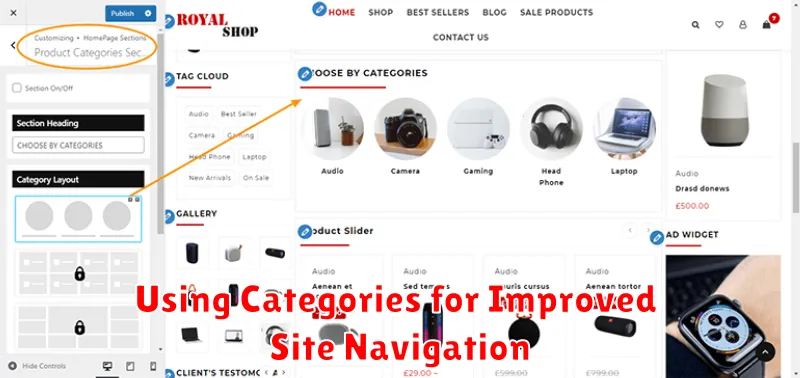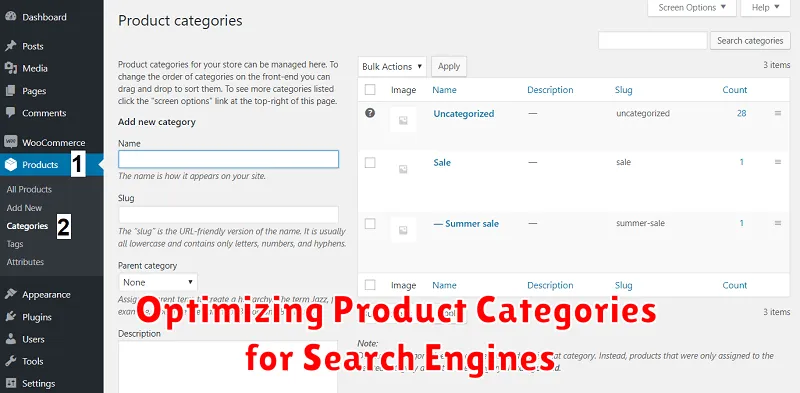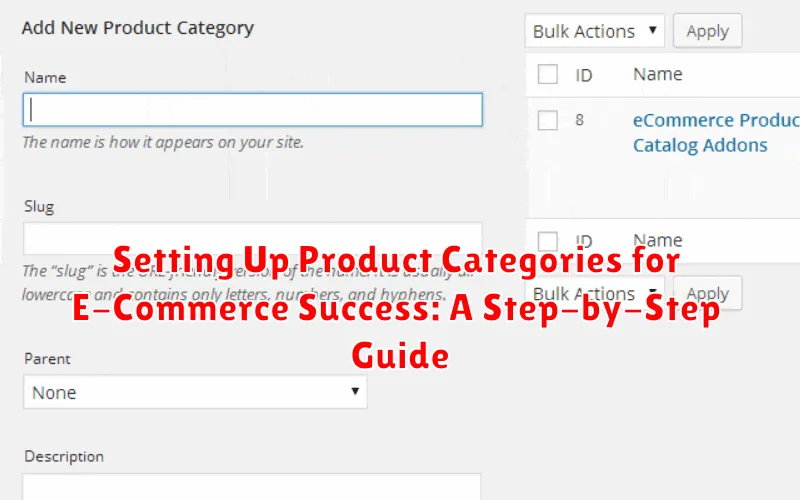In the competitive landscape of e-commerce, a well-structured product categorization system is paramount to success. Product categories act as the roadmap for customers navigating your online store, directly impacting user experience, search engine optimization (SEO), and ultimately, sales. This comprehensive guide provides a step-by-step approach to setting up product categories that will streamline your e-commerce operations and enhance customer satisfaction. Learn how to effectively organize your products, optimize for search engines, and create a seamless browsing experience that converts visitors into loyal customers. Mastering product category management is an essential skill for any e-commerce entrepreneur seeking to thrive in the digital marketplace.
This step-by-step guide will delve into the intricacies of e-commerce product categorization, offering practical advice and actionable strategies. From understanding the importance of a logical hierarchy to leveraging keyword research for optimized product category names, we’ll cover all the essential elements. Whether you are launching a new online store or seeking to refine your existing product category structure, this guide will equip you with the knowledge and tools you need to achieve e-commerce success. We’ll explore best practices for product category descriptions, discuss the benefits of clear and concise product category pages, and provide insights into analyzing and adapting your categorization strategy based on performance data.
Understanding the Importance of Product Categories
Well-defined product categories are crucial for e-commerce success. They provide the foundation for a positive user experience, enabling customers to easily navigate your online store and find what they need. Effective categorization directly impacts sales and customer satisfaction.
Improved Navigation: Clear categories simplify browsing, allowing customers to quickly drill down to specific product types. This reduces frustration and increases the likelihood of a purchase. A confused customer is a lost customer.
Enhanced Search Functionality: Categories play a vital role in site search. They allow search algorithms to better understand your product offerings and deliver more relevant results to shoppers, increasing search precision.
Targeted Marketing: Well-structured categories enable you to target specific customer segments with personalized promotions and recommendations based on their browsing history and preferences within a category. This leads to higher conversion rates.
Streamlined Inventory Management: Categories make it easier to manage inventory, track stock levels, and analyze sales data for specific product groups, leading to more efficient business operations.
Choosing the Right E-Commerce Platform for Category Management
Selecting the right e-commerce platform is crucial for effective category management. The platform should support your specific business needs and allow for easy organization and navigation of your product catalog.
Consider these key factors when evaluating platforms:
- Scalability: Can the platform handle your current product catalog and future growth?
- Flexibility: Does it allow for customized category structures and hierarchies?
- User-Friendliness: Is the platform easy for you and your team to manage categories, add products, and make updates?
- Features: Does it offer features like bulk product uploads, automated categorization, and robust search functionality?
- Integrations: Does the platform integrate with your existing systems, such as inventory management and accounting software?
Research different platforms and compare their features and pricing to find the best fit for your business. Choosing a platform that streamlines category management will save you time and effort in the long run.
Defining Your Product Hierarchy
A well-defined product hierarchy is crucial for organizing your products effectively. Think of it as a family tree for your inventory. This structure dictates how customers navigate your online store and find what they’re looking for. A logical hierarchy reduces friction in the buying process and improves the overall user experience.
Start by identifying your main product categories. These are the broadest groupings of your products. For example, a clothing store might have main categories like “Men’s,” “Women’s,” and “Children’s.” From there, break each main category down into subcategories. Under “Men’s,” you might have subcategories such as “Shirts,” “Pants,” and “Shoes.” You can further refine these subcategories into more specific levels if needed, creating a hierarchy that makes intuitive sense to your customers.
Consider the breadth and depth of your product catalog when defining your hierarchy. A simple hierarchy is best for smaller inventories, while a more complex, multi-tiered structure may be necessary for larger, more diverse product lines. The goal is to create a balanced structure that is neither too broad nor too deep, providing clear navigation without overwhelming the customer.
Creating Clear and Concise Category Names
Clear and concise category names are crucial for a positive user experience. Customers should be able to quickly understand what products they’ll find within each category. Ambiguous or overly technical names can lead to confusion and frustration, ultimately hindering sales.
Keep category names brief and descriptive. Avoid jargon or internal terminology that customers might not understand. Instead, use language that is familiar and relevant to your target audience.
Consistency is key when naming categories. Establish a naming convention and stick to it throughout your site. This could involve using all lowercase letters, capitalizing the first letter of each word, or another consistent format. This creates a more professional and organized feel.
Consider using keywords in your category names to improve your site’s search engine optimization (SEO). Research relevant keywords that customers are likely to use when searching for products like yours. However, prioritize clarity and user experience over keyword stuffing.
Best Practices for Product Categorization
Consistency is key. Maintain a uniform structure across all categories. This ensures a predictable and user-friendly experience.
Think like your customer. Consider how your target audience would search for products and organize categories accordingly. Use familiar terminology and avoid jargon.
Start broad, then get specific. Implement a hierarchical structure that allows for both high-level browsing and granular filtering.
Regularly review and refine. Analyze category performance and make adjustments based on customer behavior and sales data. This helps optimize navigation and improve discoverability.
Don’t over-categorize. Too many categories can overwhelm customers. Aim for a balance between specificity and simplicity.
Using Categories for Improved Site Navigation

Well-structured product categories are essential for a positive user experience. They allow customers to easily browse and find what they’re looking for, reducing frustration and increasing sales. Think of your categories as a roadmap guiding customers through your online store.
A logical hierarchy is key. Start with broad categories and then break them down into more specific subcategories. For example, “Clothing” could be a main category, with subcategories like “Men’s Clothing,” “Women’s Clothing,” and “Children’s Clothing.” Further subcategories under “Men’s Clothing” might include “Shirts,” “Pants,” and “Jackets.”
Clear category labels are crucial. Use terms your customers understand and search for. Avoid jargon or internal terminology that might confuse them. Keep labels concise and descriptive.
Consider the number of categories. Too few can make navigation overwhelming, while too many can make it feel cluttered and inefficient. Strive for a balance that makes sense for your product range.
Optimizing Product Categories for Search Engines

Well-structured product categories are crucial for search engine optimization (SEO). By optimizing your categories, you improve your site’s visibility on search engine results pages (SERPs), driving organic traffic and increasing sales.
Keyword Research: Begin by conducting thorough keyword research to identify the terms your target audience uses when searching for products like yours. Incorporate these relevant keywords naturally within your category names and descriptions.
Category Page Optimization: Each category page should be optimized like a landing page. This includes using unique, keyword-rich title tags and meta descriptions. Provide comprehensive, informative content that satisfies user search intent.
Structured Data: Implementing structured data markup, such as schema.org, helps search engines understand the context of your product categories. This can enhance your search visibility and lead to rich snippets in search results.
Internal Linking: Strategically link between your categories and product pages. This improves site navigation for both users and search engine crawlers, strengthening the overall SEO structure of your e-commerce website.
Managing and Maintaining Your Product Categories
Regular maintenance of your product categories is crucial for long-term e-commerce success. Outdated or poorly organized categories can lead to customer frustration and lost sales.
Implement a consistent review schedule. Depending on the size and volatility of your inventory, this could be monthly, quarterly, or bi-annually. During these reviews, analyze category performance. Look for categories with low traffic or conversion rates. This data can indicate a need for adjustments.
Stay adaptable. As your business grows and evolves, so should your product categories. Be prepared to add, remove, or rename categories as needed. This ensures your categorization remains relevant and user-friendly.
Consider using category management software. These tools can automate tasks like categorization and tagging, freeing up your time for strategic decision-making.
Common Mistakes to Avoid in Product Categorization
Effective product categorization is crucial for e-commerce success. However, several common pitfalls can hinder its effectiveness. Avoiding these mistakes will significantly improve user experience and boost sales.
Overlapping categories create confusion. Ensure each product belongs to a single, well-defined category. Too few categories can make navigation overwhelming, while too many categories can make it difficult for customers to find what they’re looking for. Strive for a balanced structure.
Inconsistent naming conventions also cause problems. Establish a clear and consistent naming scheme across all categories. Using unclear category labels can lead to frustration. Use concise and descriptive labels that accurately reflect the products within.
Finally, neglecting to regularly update categories as your product offerings evolve can result in a disorganized and outdated structure. Consistent maintenance is essential for a successful e-commerce site.

